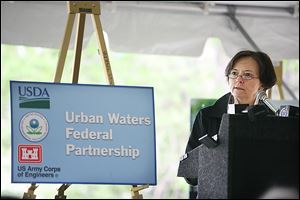
Feds: West Lake Erie basin needs special strategy, care
5/15/2013
Susan Hedman, Midwest regional administrator of the U.S. Environmental Protection Agency, said the western Lake Erie basin, including the future Middle-grounds Metropark, will get special protection under the Urban Waters Federal Partnership Program.
Lest there be any confusion, the U.S. government sees this region’s western Lake Erie basin as one of America’s most important collections of inland rivers and streams.
The basin is now one of 11 nationally that the Obama Administration has identified for special attention on a broader, more holistic basis.
The designation, announced nationally late last week, was discussed locally Tuesday during a news conference at the future Middlegrounds Metropark near downtown Toledo.
Several federal officials who attended said it will help the region leverage more federal funding for restoration work, especially in long-neglected urban corridors.
But the big change will be one that will go largely unnoticed by the general public: At least 13 federal agencies or centers have been put on notice to rethink their strategy and work with state and local officials on water-quality issues more in terms of regional hydrology, exclusive of political jurisdictions. That means future policies in Fort Wayne and Defiance, for example, will need to consider potential impacts on Toledo and vice versa.
The western Lake Erie basin is a collection of nine inland watersheds. It encompasses most of northwest Ohio, as well as portions of northeast Indiana and southeast Michigan.
The Maumee River, the Ottawa River, Swan Creek, and other bodies of water which flow into western Lake Erie and its tributaries are included, as is the lake’s western basin and its two most important bays, Maumee Bay and Sandusky Bay.
U.S. Rep. Marcy Kaptur (D., Toledo) said it’s an important designation because “no one place has jurisdiction over water.”
“We have a tri-state watershed and nobody in charge,” Miss Kaptur said. “With rain events being what they are, we need to think more as a watershed.”
Susan Hedman, Midwest regional administrator for the U.S. Environmental Protection Agency, said the western Lake Erie basin becomes part of a program established two years ago to provide special protection to significant waterways, such as the Maumee, which flow through the nation’s cities.
Under the Urban Waters Federal Partnership, the federal government promotes more regional cooperation to enhance scenic beauty, water quality, public health, and recreation, she said.
“Often, cities have turned their backs to urban rivers,” Ms. Hedman said.
Officials said it was no coincidence their site for Tuesday’s gathering was the future Middlegrounds Metropark, 111 Ottawa St., which remains largely undeveloped.
Metroparks of the Toledo Area has said it will provide some of the region’s best public access to the Maumee River when the park opens in 2015.
“One of the focuses is to reconnect people back to the waterfront here along the Maumee River,” Tim Schetter, Metroparks manager of land planning and acquisition, said.
Getting people to reconnect with waterways generates more support for them, officials said.
“The bottom line is the quality of life,” Mayor Mike Bell said. “Who in Toledo wouldn’t want something like this to occur?”
Western Lake Erie is the most ecologically sensitive and biologically productive part of the Great Lakes, which together hold 20 percent of the world’s fresh surface water.
Contact Tom Henry at: thenry@theblade.com or 419-724-6079.